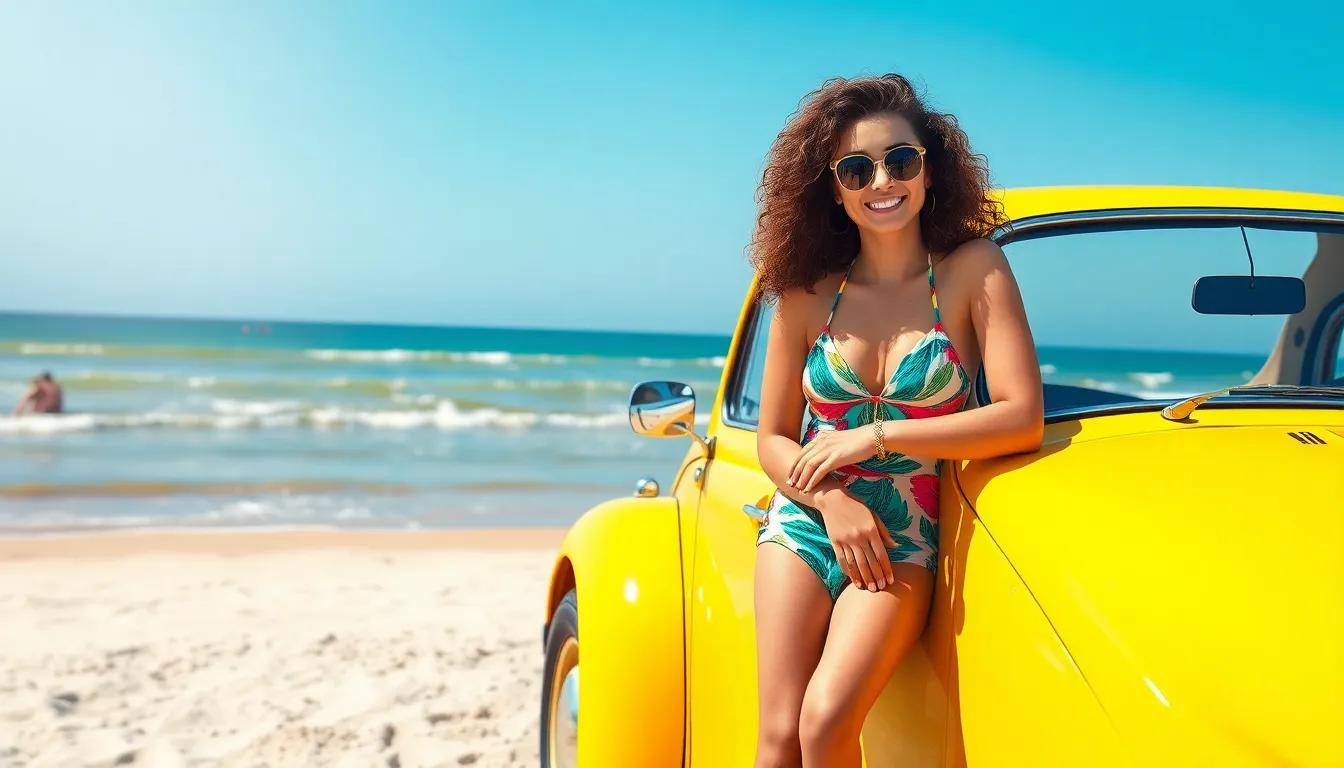Picture this: you’re cruising down sandy shores with the ocean breeze flowing through your hair and salt-kissed air filling your lungs. We’re talking about the ultimate coastal driving experience that transforms ordinary beach trips into unforgettable adventures.
Beach cars aren’t just vehicles – they’re your ticket to exploring hidden coastal gems that regular cars simply can’t reach. From rugged dune buggies to lifted 4x4s built for sand navigation, these specialized machines open up a industry of seaside possibilities that most drivers never experience.
We’ve all seen those iconic images of surfers loading their boards onto weathered beach cruisers or families packed into colorful dune buggies racing across pristine sands. But choosing the right beach car involves more than just picking something that looks cool. Whether you’re planning weekend coastal getaways or considering a permanent move to beach living, understanding your options can make all the difference.
Classic Beach Cruisers That Defined Coastal Culture
Understanding which vehicles shaped beach culture helps us appreciate the foundation of today’s coastal car community. These iconic models established the template for what makes a perfect beach cruiser.
Volkswagen Beetle: The Original Beach Bug
Beetles transformed into beach legends through their simple design and unmatched accessibility. The air-cooled engine eliminated overheating concerns during hot summer drives, while the lightweight construction made them ideal for soft sand navigation. California surfers adopted Beetles in the 1960s because they could haul surfboards on roof racks without struggling up coastal hills.
Customization became part of the Beetle beach culture experience. Owners stripped away unnecessary parts, installed roll bars, and added oversized tires for better sand traction. The removable doors and fenders created an open-air feeling that perfectly matched the beach lifestyle philosophy.
We still see modified Beetles at beach gatherings today, proving their lasting impact on coastal car culture. Their affordability allowed young surfers and beach enthusiasts to own reliable transportation that could handle both city streets and sandy beach access roads.
Ford Bronco: Rugged Coastal Adventures
Broncos dominated the beach scene from 1966 with their removable roof and doors design. The compact SUV offered serious off-road capability that could tackle rocky coastal trails and deep sand dunes equally well. Early Broncos featured a 170-cubic-inch inline-six engine that provided adequate power without the complexity of larger V8 options.
Beach communities embraced Broncos because they combined utility with fun factor. Families could load camping gear, coolers, and beach equipment while maintaining the open-air experience that defined coastal driving. The short wheelbase made parking easier in crowded beach lots, while the four-wheel-drive system handled challenging terrain.
Collectors now pay premium prices for original Broncos in good condition. We see restored models at classic car shows and beach events, where they continue attracting attention from both vintage car enthusiasts and younger drivers discovering their appeal.
Jeep CJ Series: Open-Air Freedom
CJ models established the template for beach vehicle versatility starting in the 1940s. The military-inspired design featured removable doors, fold-down windshield, and convertible soft top that created the ultimate open-air beach experience. Jeep’s four-wheel-drive system handled everything from wet sand to rocky coastal paths.
Beach patrol units and lifeguard services adopted CJ models because of their reliability and visibility advantages. The elevated seating position allowed better views of beach conditions, while the rugged construction withstood constant salt air exposure and sandy conditions.
Surfers particularly favored CJ-5 and CJ-7 models during the 1970s and 1980s. We can trace many modern Jeep Wrangler features back to these classic CJ innovations that prioritized function over comfort. The simple mechanical systems made repairs easy, which was essential for vehicles spending time in harsh coastal environments.
Modern Beach Cars Built for Sand and Surf
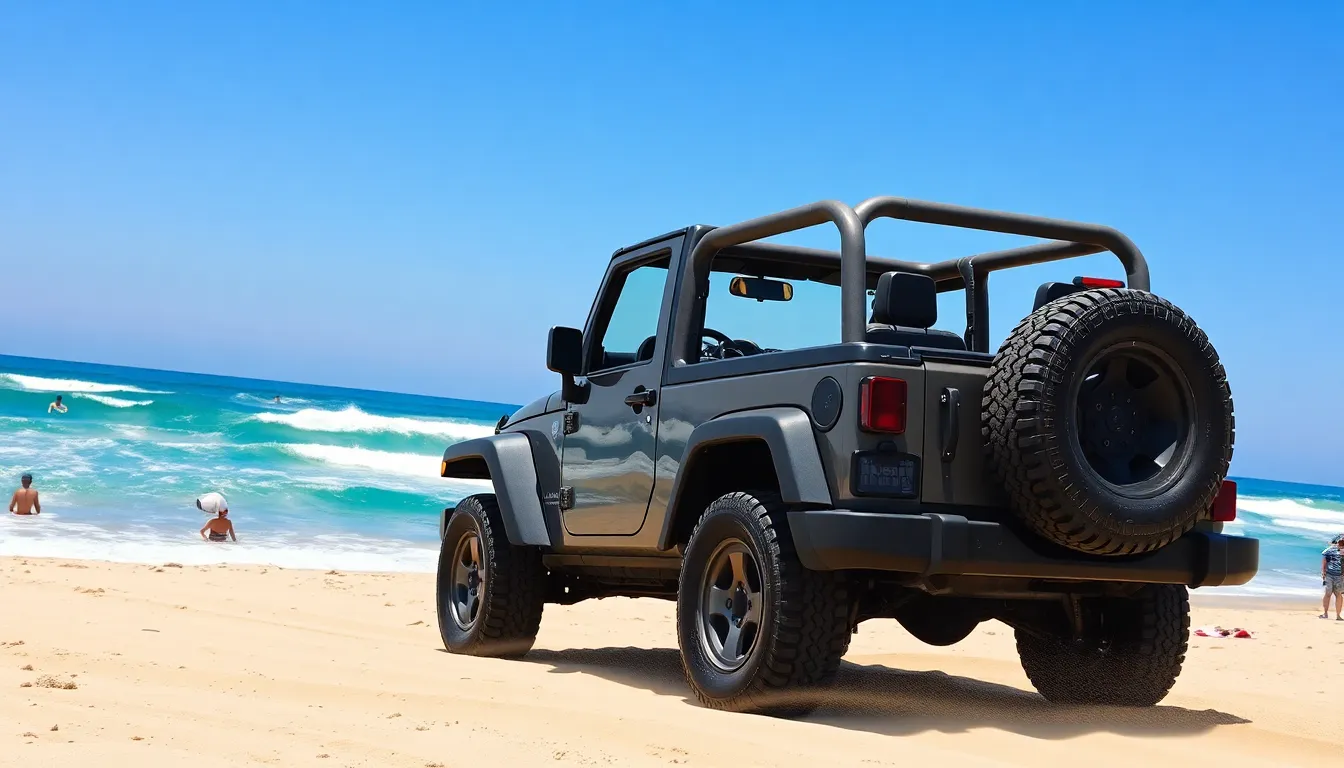
Today’s beach car manufacturers have refined their coastal vehicle designs to offer unmatched performance on sand while maintaining daily driving comfort. These contemporary models combine advanced 4×4 systems with beach-ready features that make coastal adventures more accessible than ever.
Jeep Wrangler: Contemporary Coastal King
Jeep Wrangler models dominate modern beach scenes with their removable doors and fold-down windshields that create the ultimate open-air coastal experience. The 2024 Wrangler Unlimited offers 10.8 inches of ground clearance and approach angles up to 44 degrees, making it capable of tackling steep beach access roads and soft sand dunes.
Sand-exact traction control systems in the Wrangler include specialized driving modes like Sand/Snow that optimize throttle response and shift patterns for loose terrain. The available Rock-Trac 4×4 system delivers a 4:1 low-range gear ratio, providing the torque multiplication needed for crawling through deep sand at low speeds.
Modern Wrangler variants like the Rubicon 392 feature disconnecting sway bars and Dana 44 axles that enhance articulation over uneven beach terrain. The vehicle’s 31-inch tires and selectable differential locks ensure maximum traction when handling from pavement to sand without getting stuck.
Toyota 4Runner: Reliable Beach Companion
Toyota 4Runner’s body-on-frame construction delivers the durability needed for repeated beach excursions while maintaining a comfortable ride on highway approaches to coastal destinations. The TRD Pro model includes Fox shocks and a 1-inch suspension lift that improves clearance over beach debris and rocks.
Multi-terrain select technology in the 4Runner offers exact settings for sand driving that adjust engine response, transmission shift points, and traction control intervention. The available Kinetic Ever-changing Suspension System automatically adjusts sway bar stiffness to maintain stability on sand while improving articulation over obstacles.
Practical beach features include a power rear window that lowers independently from the tailgate, allowing airflow while keeping sand out of the cargo area. The 4Runner’s 9.6-inch ground clearance and 33-degree departure angle help prevent scraping when exiting steep beach access points.
Ford Bronco Sport: Urban Beach Utility
Ford Bronco Sport bridges the gap between city driving and weekend beach adventures with its compact size that fits urban parking while offering genuine off-road capability. The advanced 4×4 system includes seven selectable terrain modes, including a dedicated Sand mode that optimizes power delivery for loose surfaces.
Intelligent 4×4 technology monitors wheel slip and road conditions 100 times per second, automatically captivating four-wheel drive when sensors detect sand or loose terrain. The system’s rear differential lock and electronic stability control work together to maintain traction during beach launches and recoveries.
Urban-friendly dimensions of 173 inches in length make the Bronco Sport easier to maneuver in beach town traffic and parking lots compared to full-size beach vehicles. The available Badlands package includes all-terrain tires, skid plates, and rock crawl mode that enhance capability without sacrificing daily drivability.
Electric Beach Cars Leading the Green Revolution
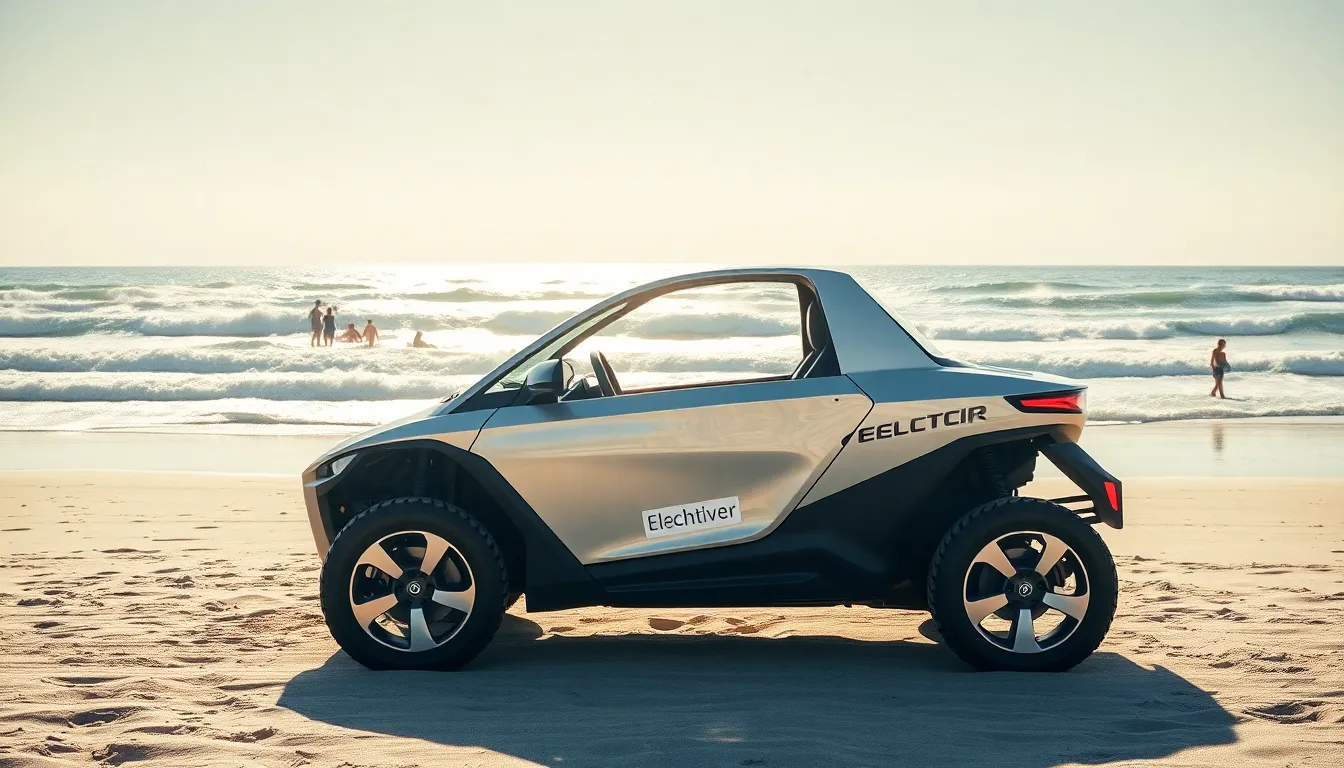
Electric vehicles are transforming coastal driving by offering zero emission adventures without sacrificing the performance beach enthusiasts demand. We’re witnessing a surge in electric beach cars that combine environmental responsibility with the rugged capabilities needed for sandy terrain exploration.
Tesla Model Y: Sustainable Coastal Cruising
Tesla Model Y delivers impressive beach performance through its dual motor all wheel drive system that provides superior traction on loose sand. The vehicle’s 326 mile EPA range ensures we can reach remote coastal destinations without range anxiety, while its 14.1 inch ground clearance handles moderate beach access roads effectively.
Advanced traction control algorithms automatically adjust power distribution between wheels when handling soft sand conditions. The Model Y’s sealed battery pack sits low in the chassis, creating a stable center of gravity that enhances handling on uneven beach terrain.
Smart air suspension maintains optimal ride height across different surface types, from paved coastal highways to sandy beach approaches. We appreciate the massive glass roof that provides panoramic ocean views during scenic coastal drives, creating an open air feeling similar to traditional convertible beach cars.
Rivian R1T: Electric Beach Truck Innovation
Rivian R1T revolutionizes electric beach trucks with its quad motor system that delivers independent torque to each wheel for maximum sand traction. The truck’s 14.9 inch ground clearance and 43.1 inch water fording capability make it ideal for challenging beach access points and tidal zone crossings.
Tank Turn mode allows the R1T to rotate in place by spinning left and right wheels in opposite directions, providing unmatched maneuverability in tight beach parking areas. The 1,764 pound payload capacity easily accommodates surfboards, beach gear, and camping equipment for extended coastal adventures.
Built in air compressor enables quick tire pressure adjustments for optimal sand driving performance, while the truck’s 400 mile range supports long distance beach road trips. We’re impressed by the R1T’s Camp Mode that powers external devices for beach camping without running down the main battery.
Ford Mustang Mach-E: Eco-Friendly Shore Runner
Ford Mustang Mach-E brings electric performance to beach driving with its 480 horsepower GT variant that accelerates from 0 to 60 mph in 3.5 seconds on hard packed sand. The vehicle’s intelligent all wheel drive system automatically distributes torque for optimal traction when transitioning from pavement to beach surfaces.
Unbridled driving mode maximizes power output for challenging sandy conditions, while the Mach-E’s low center of gravity enhances stability during high speed coastal cruising. The 312 mile EPA range provides sufficient power for day long beach adventures and return trips to urban charging stations.
FordPass charging network integration helps locate coastal charging stations along popular beach routes, ensuring we can recharge during extended shore excursions. The Mach-E’s spacious interior accommodates beach gear while maintaining the sleek profile that cuts through coastal headwinds efficiently.
Essential Features Every Beach Car Should Have
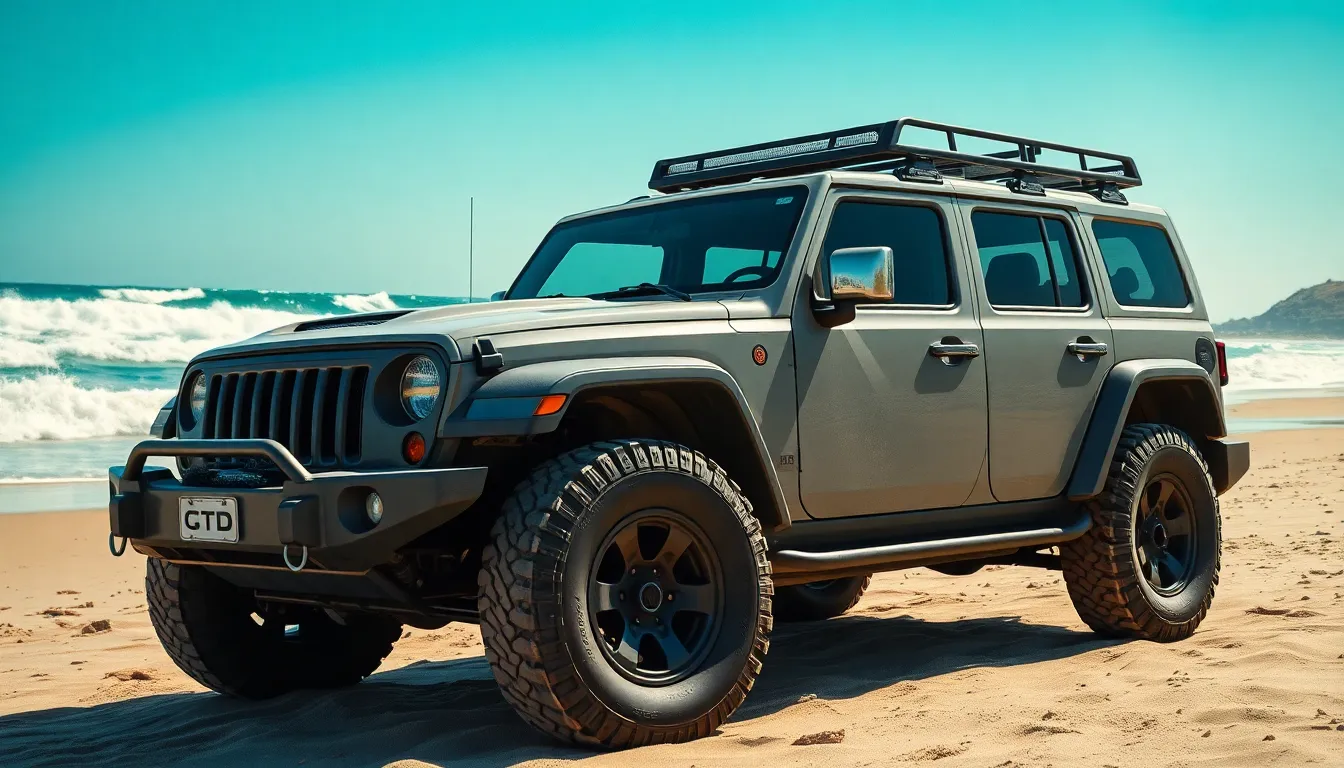
Finding the perfect beach car means looking beyond style to focus on practical features that handle coastal challenges. We’ve identified three critical features that separate genuine beach vehicles from ordinary cars.
Corrosion-Resistant Materials for Salt Air Protection
Salt air attacks metal components relentlessly, making corrosion resistance our top priority when evaluating beach cars. Marine grade aluminum and stainless steel components protect critical systems like exhaust pipes, brake lines, and suspension parts from premature rust damage.
Galvanized steel frames offer superior protection compared to standard steel construction, extending vehicle lifespan in coastal environments by up to 40% according to automotive corrosion studies. Premium beach cars feature zinc coated fasteners, aluminum body panels, and plastic undercarriage shields that create barriers against salt spray penetration.
Protective coatings applied to vulnerable areas provide additional defense against oxidation. We recommend vehicles with powder coated suspension components, ceramic coated exhaust systems, and marine grade wiring harnesses that resist salt water intrusion.
All-Wheel Drive for Sand Navigation
Sand navigation demands traction systems that distribute power effectively across all four wheels. Electronic limited slip differentials prevent wheels from spinning uselessly in soft sand by automatically transferring torque to wheels with better grip.
Advanced traction control systems monitor wheel slip rates and adjust power delivery within milliseconds to maintain forward momentum. Hill descent control assists drivers handling steep beach access roads by maintaining steady speeds without brake pedal input.
Selectable drive modes optimize performance for different sand conditions, with dedicated sand settings that modify throttle response, transmission shift points, and stability control parameters. Low range gearing provides the crawling speeds necessary for technical beach terrain while reducing strain on drivetrain components.
Easy-to-Clean Interior Surfaces
Beach adventures inevitably bring sand, salt, and moisture inside vehicles, making cleanable interior materials essential for long term enjoyment. Waterproof vinyl seats resist staining from wet swimsuits and allow quick cleanup with simple soap and water answers.
Rubber floor mats with raised edges contain sand and water while protecting carpet underneath. Drain plugs in floor panels enable thorough washouts after particularly sandy adventures, a feature pioneered by Jeep and now adopted by several manufacturers.
Sealed electrical connections prevent corrosion from humid air and occasional water exposure during interior cleaning. We prioritize vehicles with marine grade switches, waterproof USB ports, and moisture resistant infotainment systems that withstand coastal conditions without failure.
Top Convertible Beach Cars for Ultimate Open-Air Experience
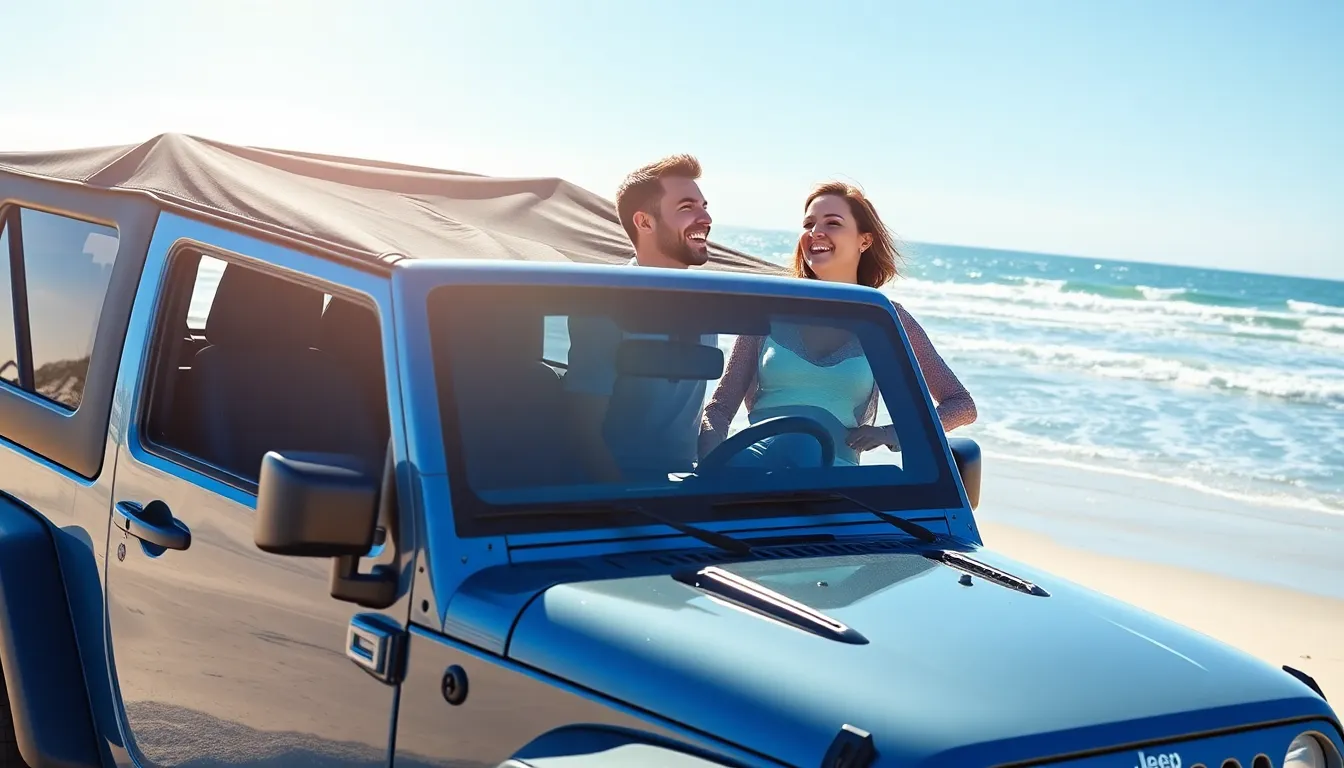
Nothing beats the feeling of salt air rushing through your hair as you cruise along the coastline. We’ve selected the most versatile convertible beach cars that deliver authentic open air experiences while maintaining the rugged capabilities needed for sandy adventures.
Jeep Wrangler Unlimited: Removable Doors and Top
Jeep Wrangler Unlimited stands as the ultimate convertible beach vehicle, offering complete freedom through its removable doors and soft top system. We can transform this four door SUV from a traditional vehicle to a completely open experience in minutes, thanks to its innovative design that requires no tools for door removal.
Key Convertible Features:
- Removable soft top and hardtop options
- Tool free door removal system
- Fold down windshield capability
- Weather resistant interior materials
Advanced Rock Trac 4×4 system provides exceptional sand traction through electronic locking differentials and 4:1 low range gearing. We appreciate the 33 inch all terrain tires that come standard on higher trims, delivering superior flotation on soft sand surfaces.
Ground clearance reaches 10.8 inches on Rubicon models, allowing navigation over driftwood and beach debris without concern. The interior features drain plugs and waterproof materials, making post beach cleanup effortless for families who frequent coastal destinations.
Ford Bronco Sasquatch: Maximum Off Road Capability
Ford Bronco Sasquatch package delivers unmatched off road performance in a convertible beach platform, combining serious sand capability with open air freedom. We’re impressed by the advanced Terrain Management System that includes dedicated Sand mode, automatically adjusting throttle response and transmission shift points for optimal beach driving.
Sasquatch Package Highlights:
- 35 inch Goodyear Wrangler mud terrain tires
- 4.70 final drive ratio for improved low end torque
- Bilstein position sensitive dampers
- Rock crawl mode for technical beach access
Removable roof sections and doors create multiple convertible configurations, from partial open air to completely exposed driving experiences. The modular design allows us to remove just the front roof panels for highway comfort or strip everything away for maximum beach immersion.
Electronic disconnecting sway bar system provides exceptional articulation over uneven sand dunes and rocky coastal approaches. We value the 11.6 inches of ground clearance that prevents underbody damage when crossing deeper sand channels or handling beach access points.
Toyota RAV4: Affordable Beach Adventure
Toyota RAV4 offers the most budget friendly entry into convertible beach driving, featuring a large panoramic sunroof that provides important open air experience without the complexity of removable panels. We recommend this practical choice for occasional beach visitors who want versatility without premium pricing.
Value Oriented Features:
- Panoramic moonroof with slide and tilt functions
- Ever-changing Torque Vectoring all wheel drive
- Multi Terrain Select with Sand mode
- Weather resistant seat materials
All wheel drive system automatically distributes power between wheels for improved sand traction, while Multi Terrain Select optimizes engine and transmission responses for different surface conditions. We find the 8.6 inches of ground clearance adequate for most beach access roads and parking areas.
Interior space accommodates beach gear efficiently with 37.5 cubic feet of cargo capacity behind the rear seats. The hybrid variants deliver exceptional fuel economy for long coastal road trips, achieving up to 40 mpg in combined driving conditions while maintaining all wheel drive capability.
Budget-Friendly Beach Cars Under $30,000
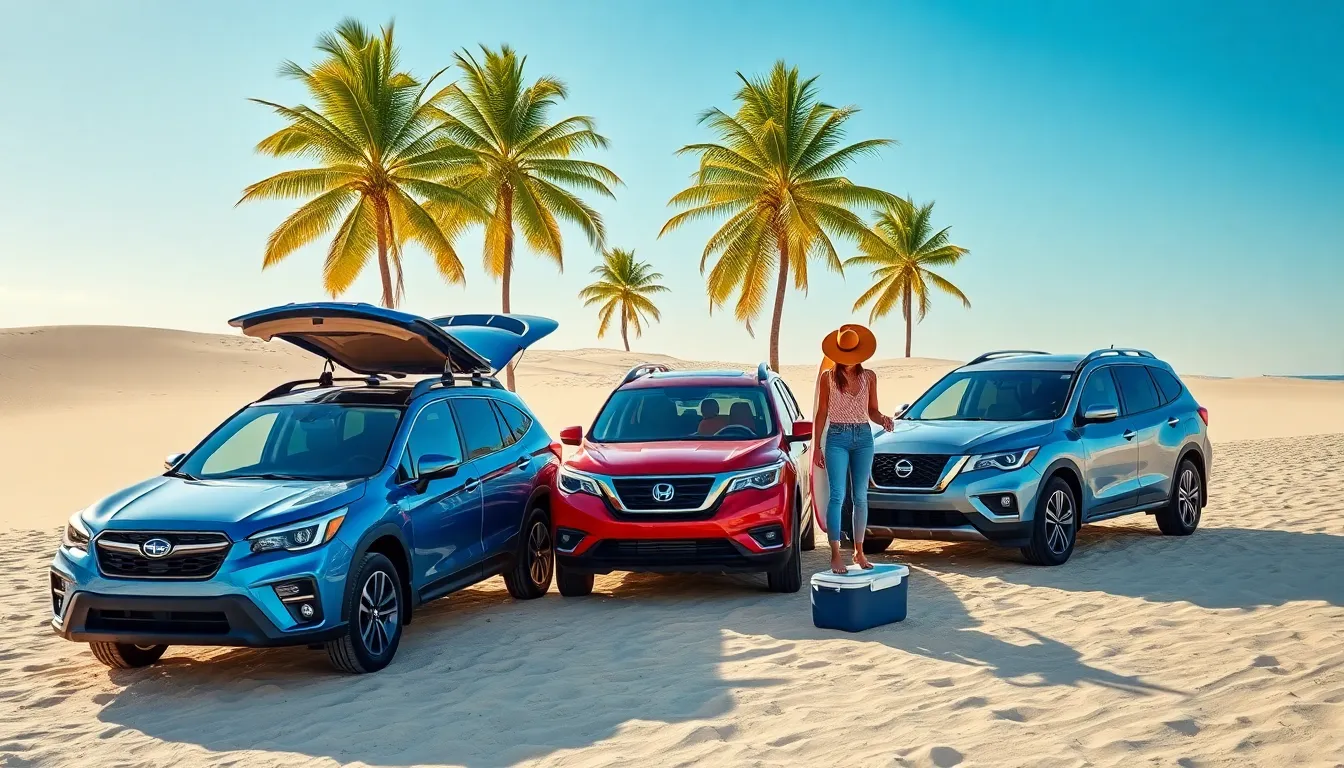
We’ve identified three exceptional beach cars that deliver coastal performance without breaking your budget. These affordable options provide reliable access to sandy destinations while offering practical features for daily driving.
Subaru Crosstrek: Compact Coastal Value
Starting around $24,895, the Subaru Crosstrek offers impressive beach capability in a fuel efficient package. Standard all wheel drive comes equipped on every model, providing confident traction across loose sand and wet coastal roads. Ground clearance measures 8.7 inches, allowing navigation over beach debris and uneven dunes that would stop lower vehicles.
Protective cladding shields the body from sand scratches and salt corrosion, while the interior features water resistant seat materials. Cargo space reaches 20.8 cubic feet with seats up, accommodating surfboards, beach chairs, and coolers for family outings. EPA ratings deliver 29 mpg city and 33 mpg highway, keeping fuel costs manageable during frequent beach trips.
X Mode terrain management enhances traction on sand by controlling engine output and transmission response. Hill Descent Control maintains steady speeds when handling steep dune faces or boat ramps. These features transform the compact Crosstrek into a capable coastal companion that handles both urban commutes and weekend beach adventures.
Honda Pilot: Family Beach Hauler
Priced from $38,080 in base trim, the Honda Pilot maximizes passenger space and cargo capacity for large beach groups. Eight passenger seating accommodates extended families, while 16.5 cubic feet of cargo space expands to 84.5 cubic feet with seats folded. Intelligent Traction Management includes Snow mode that improves grip on soft sand by adjusting torque distribution.
All weather floor mats and seat protectors shield the interior from sandy feet and wet swimsuits. Power tailgate simplifies loading heavy beach equipment like umbrellas, grills, and multiple coolers. Roof rails support cargo boxes or kayak carriers, expanding hauling capacity for longer coastal vacations.
Variable Cylinder Management helps maintain fuel economy during highway drives to distant beaches. Ground clearance reaches 8.0 inches, providing adequate protection from beach rocks and driftwood. The Pilot’s combination of space, comfort, and capability makes it ideal for families who frequently visit beaches with children and extensive gear.
Nissan Pathfinder: Versatile Shore Vehicle
Starting at $34,930, the Nissan Pathfinder balances beach capability with refined on road manners. Intelligent All Wheel Drive automatically engages when sensors detect slipping, providing traction across various sand conditions. Seven drive modes include Sand mode that optimizes throttle response and transmission shifting for loose terrain.
Cargo capacity measures 16.6 cubic feet behind the third row, expanding to 80.5 cubic feet with rear seats folded. Remote engine start with climate control allows cooling the cabin before loading beach gear on hot summer days. Zero Gravity seats reduce fatigue during long coastal drives, while tri zone climate control keeps all passengers comfortable.
Advanced safety features include Intelligent Emergency Braking and Blind Spot Warning, essential for crowded beach parking areas and busy coastal highways. Tow capacity reaches 6,000 pounds when properly equipped, enabling transport of boat trailers or travel trailers to beachside campgrounds. The Pathfinder delivers family friendly versatility that adapts to various coastal adventures without exceeding budget constraints.
Luxury Beach Cars for Premium Coastal Living
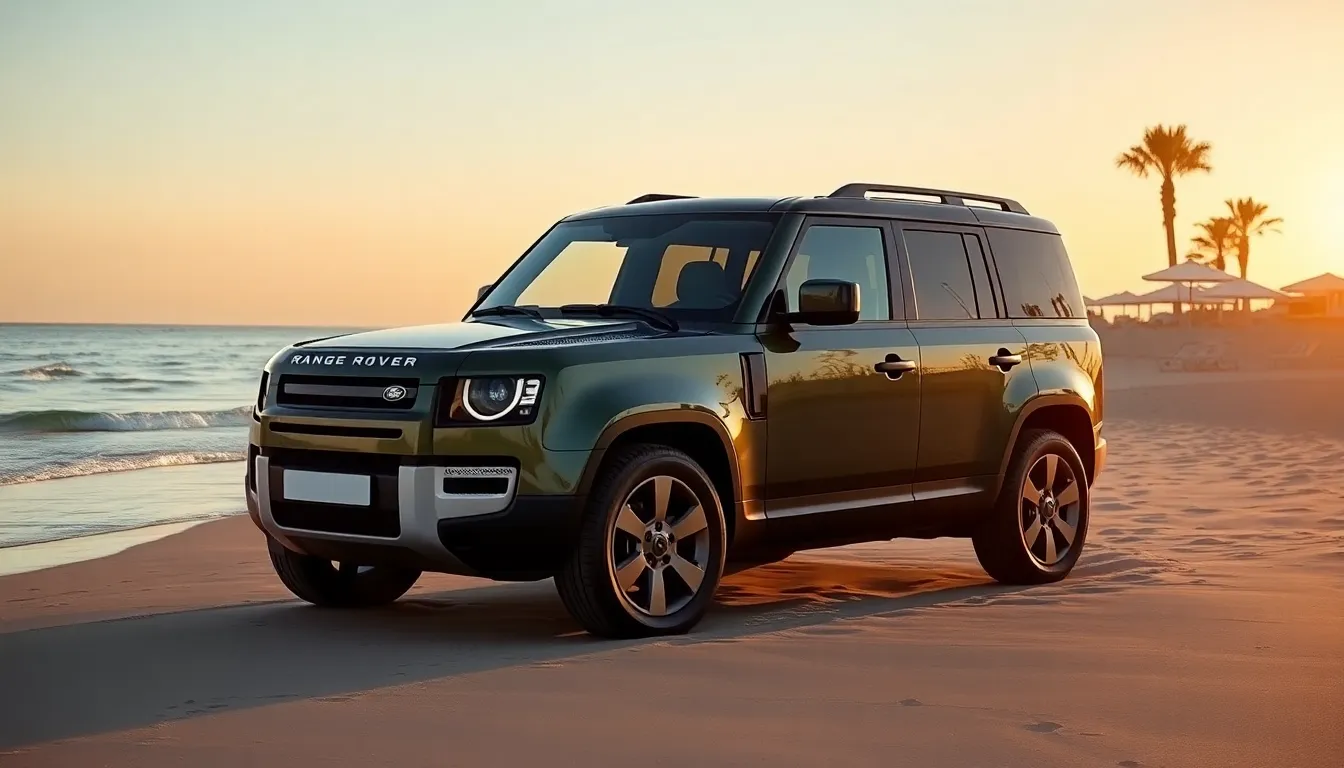
Premium beach vehicles combine sophisticated engineering with rugged coastal capabilities, delivering uncompromising performance for discerning drivers who demand the finest in oceanside adventures.
Range Rover Defender: British Beach Elegance
Terrain Response technology transforms the Range Rover Defender into a sophisticated sand navigator that effortlessly conquers challenging coastal environments. Advanced electronic systems automatically adjust suspension height, throttle response, and traction control when encountering soft sand conditions. Wading capabilities extend up to 35.4 inches, allowing confident navigation through tidal pools and beach access routes that would challenge lesser vehicles.
Premium interior materials resist salt air corrosion while maintaining the luxurious ambiance expected from British craftsmanship. Durable Windsor leather seats feature water resistant treatments that repel sand and moisture without sacrificing comfort during extended coastal journeys. Configurable seating arrangements accommodate beach equipment storage while preserving passenger comfort for families seeking upscale beach adventures.
Distinctive design elements blend rugged functionality with sophisticated aesthetics that command attention at exclusive coastal destinations. Removable roof panels provide open air experiences reminiscent of classic beach cruisers while maintaining structural integrity for serious off road performance. LED headlight technology ensures excellent visibility during dawn surf sessions and evening beachside gatherings.
Mercedes G-Wagon: German Engineering Meets Surf
Three differential locks provide unmatched traction control across varying sand densities, making the G-Wagon exceptionally capable on challenging beach terrain. Electronic systems monitor wheel slip and automatically engage locks to maintain forward momentum when handling through soft dunes or wet sand conditions. Ground clearance of 9.5 inches ensures adequate approach angles for beach access ramps and rocky coastal formations.
AMG performance variants deliver exhilarating acceleration that transforms beach commutes into thrilling drives along scenic coastal highways. Twin turbo V8 engines produce up to 577 horsepower while maintaining the low end torque necessary for sand driving applications. Air suspension systems automatically adjust ride height based on driving conditions, optimizing performance for both highway cruising and beach exploration.
Iconic boxy silhouette creates distinctive presence at upscale beach clubs and exclusive coastal resorts where automotive statements matter as much as performance capabilities. Hand crafted interior appointments feature premium materials like Nappa leather and brushed aluminum that withstand coastal environments while projecting refined sophistication. Ambient lighting systems create inviting cabin atmospheres for romantic sunset drives along beachfront properties.
BMW X3: Sophisticated Sand Runner
Intelligent all wheel drive seamlessly distributes power between front and rear axles to optimize traction on shifting sand surfaces without requiring driver intervention. Ever-changing stability control monitors individual wheel speeds and applies selective braking to prevent sand induced wheel spin during acceleration. Hill descent control maintains steady speeds when handling steep beach access routes or dune formations.
xDrive technology continuously monitors driving conditions and adjusts torque distribution within milliseconds to maintain optimal grip on unpredictable beach surfaces. Sand driving modes modify throttle response curves and transmission shift points to prevent wheel dig in situations that commonly strand conventional vehicles. Electronic limited slip differential enhances cornering stability when handling winding coastal roads at higher speeds.
Premium cabin features include heated and ventilated seats that provide comfort during temperature fluctuations common to coastal environments throughout different seasons. Panoramic sunroof systems open to provide convertible like experiences while maintaining structural rigidity for serious off road adventures. Advanced infotainment systems integrate navigation features specifically designed for coastal route planning and tide condition monitoring.
Maintenance Tips for Beach Cars in Coastal Environments
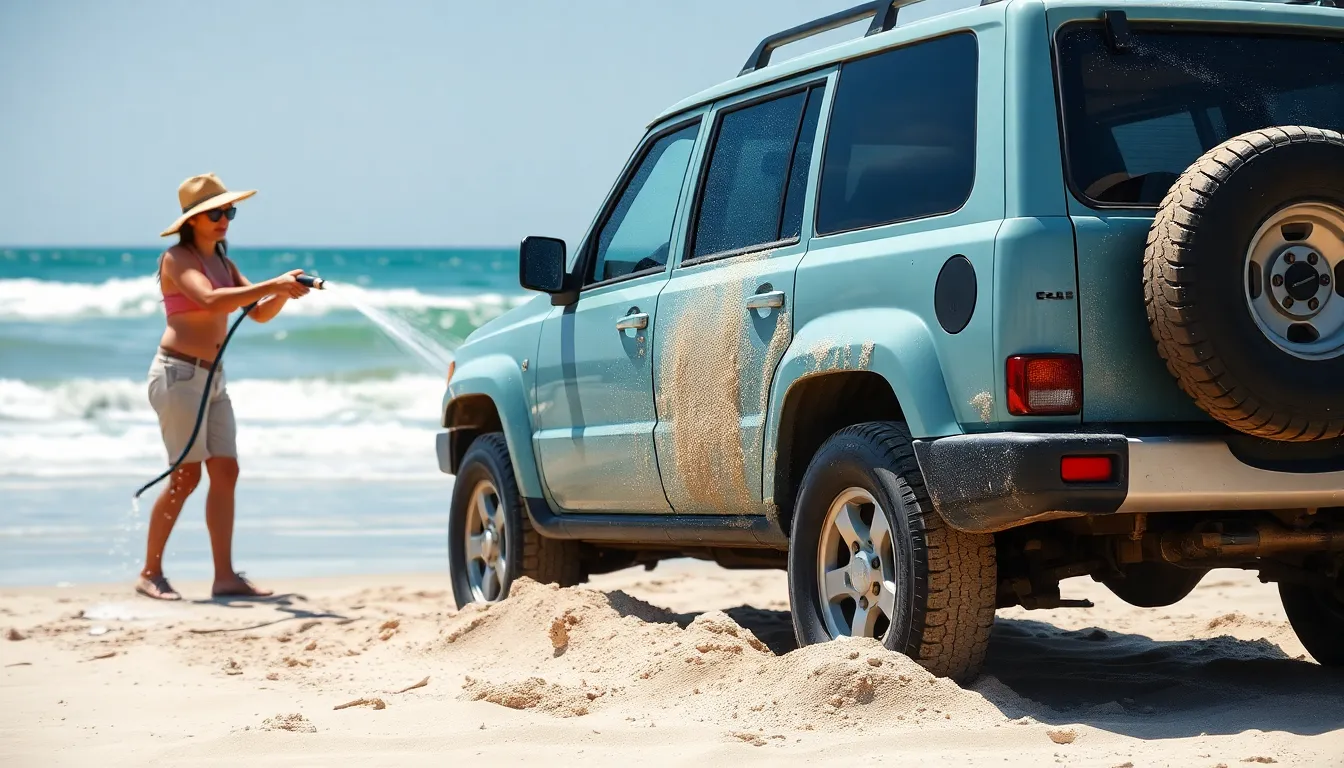
Coastal environments present unique challenges that demand specialized maintenance approaches for beach cars. We’ll share proven strategies to protect your investment and ensure reliable performance in harsh seaside conditions.
Regular Salt Water Rinse Procedures
Daily rinsing becomes essential when you’re driving regularly in coastal areas where salt spray and sand particles accumulate on every surface. We recommend starting your rinse routine immediately after each beach session, focusing first on the wheel wells where sand and salt create the most corrosive buildup.
Target high-risk areas during your rinse including door hinges, exhaust pipes, and any exposed metal components that show early signs of corrosion. Start from the top and work downward, using a pressure washer set to medium intensity to avoid forcing salt water deeper into crevices.
Schedule weekly deep rinses using a specialized salt neutralizing soap that breaks down mineral deposits more effectively than standard car wash products. We’ve found that mixing one cup of white vinegar with two gallons of water creates an affordable salt-cutting solution for thorough monthly treatments.
Undercarriage Protection Strategies
Apply marine-grade undercoating every six months to create a barrier between your vehicle’s metal components and corrosive salt air. Professional application costs between $300-500 but prevents thousands in rust damage that commonly affects brake lines, exhaust systems, and suspension components.
Inspect drain holes monthly to ensure proper water evacuation from door frames, rocker panels, and other enclosed areas where moisture accumulates. Use compressed air to clear blocked drainage points, preventing standing water that accelerates rust formation in hidden cavities.
Install mud flaps and splash guards specifically designed for beach driving to minimize sand and salt spray reaching sensitive undercarriage areas. Quality aftermarket options like WeatherTech or Husky models provide superior coverage compared to factory equipment.
Consider ceramic coating treatments for exposed metal surfaces that receive direct salt exposure during beach driving sessions. These protective layers last 12-18 months and significantly reduce cleaning time while providing enhanced corrosion resistance.
Interior Care for Sand and Moisture
Choose waterproof seat covers made from marine-grade vinyl or neoprene that withstand constant exposure to wet swimwear and sandy beach gear. We recommend brands like Coverking or Wet Okole that offer custom-fit options for exact vehicle models.
Install all-weather floor mats with raised edges that contain sand and water rather than allowing debris to reach carpet fibers underneath. Replace standard mats with heavy-duty rubber options from companies like Lloyd or Husky that feature easy-clean surfaces.
Use moisture-absorbing products like DampRid containers or silica gel packets placed strategically throughout your vehicle’s interior to prevent mold and mildew growth. Position these absorbers under seats and in storage compartments where air circulation remains limited.
Clean fabric surfaces weekly using a shop vacuum with brush attachments to remove embedded sand particles before they cause permanent wear to upholstery fibers. Follow up with fabric protectant sprays that repel moisture and make future cleaning sessions more manageable.
Conclusion
We’ve explored the complete spectrum of beach cars from timeless classics to cutting-edge electric models that redefine coastal driving. Whether you’re seeking rugged off-road capability or luxury comfort our comprehensive guide demonstrates that there’s a perfect beach car for every budget and lifestyle.
The evolution from vintage Beetles to modern Wranglers and innovative Rivians shows how manufacturers continue pushing boundaries while staying true to what makes beach driving special. Today’s options offer unprecedented versatility combining daily practicality with weekend adventure capabilities.
Remember that choosing the right beach car isn’t just about initial purchase price. Factor in long-term maintenance costs and the exact features you’ll need most. With proper care and the right vehicle your beach car investment will provide countless memorable coastal experiences for years to come.
Frequently Asked Questions
What makes a car suitable for beach driving?
A beach car needs specialized features to handle sandy terrain and coastal conditions. Essential elements include all-wheel drive or 4×4 systems for sand traction, corrosion-resistant materials to protect against salt air, and easy-to-clean interiors that can handle sand and moisture. Ground clearance and proper tire pressure also help navigate soft sand effectively.
What are the most iconic classic beach cars?
The Volkswagen Beetle, Ford Bronco, and Jeep CJ series are legendary beach cars that shaped coastal culture. The VW Beetle was perfect for sandy navigation with its lightweight design and customization options. The Ford Bronco offered rugged off-road capabilities, while the Jeep CJ series provided versatility and an open-air experience beloved by surfers.
Are electric vehicles good for beach driving?
Yes, modern electric vehicles like the Tesla Model Y, Rivian R1T, and Ford Mustang Mach-E offer excellent beach capabilities. They feature advanced all-wheel drive systems, traction control, and powerful electric motors that provide instant torque for sand driving, all while being environmentally responsible for coastal areas.
What’s the best budget-friendly beach car under $30,000?
The Subaru Crosstrek stands out as an excellent budget beach car, offering standard all-wheel drive, water-resistant interiors, and ample cargo space. Other great options include the Honda Pilot for families and the Nissan Pathfinder, which balances beach capability with refined on-road performance.
How should I maintain my beach car?
Regular saltwater rinses are crucial, especially in high-risk areas like wheel wells and undercarriage. Apply marine-grade undercoating every six months for protection. Use waterproof seat covers, all-weather floor mats, and moisture-absorbing products. Focus on cleaning sand from air filters and checking for corrosion regularly.
What’s the difference between convertible beach cars and regular beach cars?
Convertible beach cars like the Jeep Wrangler Unlimited and Ford Bronco Sasquatch offer removable doors and tops for the ultimate open-air beach experience. They maintain the same rugged capabilities as regular beach cars but provide enhanced connection to the coastal environment through customizable open-air configurations.

